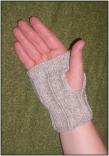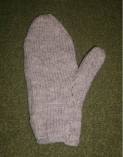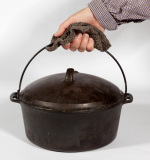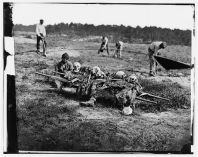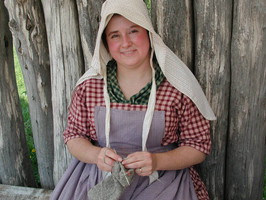
Historic Patterns
Each historic pattern kit includes a well researched, dated pattern and enough yarn to complete the project. My kits can be purchased on this page or at events.
Scroll down for more details on the:
- Muffatee Kit, 1838
- Pennsylvania Mitten Kit, 1750 - 1820
- Short Scarf Kit, 1853
- Kettle Holder Kit, 1838
What new (old) pattern am I working on now? Scroll down to the end to see!
The easiest way to purchase my yarn, historic pattern kits and knit goods is through my Etsy page at https://suzytheshepherdess.etsy.com
Or, you can email me to let me know what you want and I'll send you a PayPal invoice.
Muffatee Kit, 1838
Price: $ 11.00
Worn by both men and women, muffatees (also called mitts, wristlets or hand warmers) are a fingerless glove that will keep the hands warm while allowing your fingers the freedom to sew, knit, stir the pot over the fire or fire a gun. Modern folks will appreciate muffatees while working on the computer or sending text messages, as they keep the hand warm while leaving the fingers free to type. This pattern is from The Workwoman’s Guide, by A Lady, originally printed in 1838. I recommend this muffatee as an authentic, well-documented choice for reenactors of the early 19th century through the Civil War.
This kit is available in your choice of medium (worsted) weight or fingering weight yarn. While both were used in the 19th century, fingering weight yarn was much more common for smaller projects such as muffatees, especially for ladies wear. Choose the yarn weight that best suits you:
Medium (worsted) weight yarn is preferred by:
• Beginner knitters
• Knitters who are knitting muffatees for modern use
• Knitters who want a fast project that knits up quickly
Fingering weight yarn is preferred by:
• Experienced knitters
• Historical reenactors with high standards of authenticity
Included in This Kit:
- Suzy the Shepherdess 100% wool yarn in medium (wosted) weight OR fingering weight, enough to make one pair of muffatees.
- Two patterns. Both will result in the same muffatee, however Pattern A is knit flat with two needles and Pattern B is knit in the round with four double pointed needles.
- Original 1838 pattern
- Instructions for washing your woolens
You Will Also Need (Not Included):
- For medium weight yarn: Size 5 needles, or the size necessary to get about 12 stitches = 2 inches while knitting the pattern.
- For fingering weight yarn: Size 1 needles, or the size necessary to get about 30 stitches = 2 inches while knitting the pattern.
-
1 Stitch marker
Pennsylvania Mitten Kit, 1750 - 1820
Prices varry by size
This pattern reproduces the mittens photographed in Rural Pennsylvania Clothing, a wonderful reference documenting clothing worn in Pennsylvania by the ordinary farmer, tradesmen, day laborer and their wives and children between 1750 and 1820. I recommend this mitten as an authentic, well-documented choice for living history interpreters and reenactors of the Revolutionary War, War of 1812, Black Hawk War, the Civil War, and all eras in-between.
The pattern contains directions to knit four different sizes. The pattern is written for Adult Large with Adult Small, Child Large and Child Small in parenthesis. The price difference is because of the different amount of yarn in each kit.
- Adult Large - $20. Most men will require this size. The final mitten will be 11.5 inches in length and requires 85 grams of Suzy the Shepherdess 100% wool medium weight yarn.
- Adult Small - $16. This will fit most women. The final mitten will be 9.5 inches in length and requires 75 grams of Suzy the Shepherdess 100% wool medium weight yarn.
- Child Large - $16. The final mitten will be 7.5 inches in length and requires 60 grams of Suzy the Shepherdess 100% wool medium weight yarn.
- Child Small - $11. The final mitten will be 6 inches in length and requires 40 grams of Suzy the Shepherdess 100% wool medium weight yarn.
Included in This Kit:
- Suzy the Shepherdess medium (worsted) weight 100% wool yarn, enough to make one pair of mittens.
- Pattern
- Historical Information
- Instructions for washing your woolens
You Will Also Need (Not Included):
- Size 5 double-pointed needles, or the size necessary to get 6 stitches per inch while knitting stockinette (in the round).
- 3 Stitch markers
- 1 Stitch holder
Short Scarf Kit, 1853 (The Comfortable Comforter)
Price: $ 25.00
The original is called “A Comfortable Comforter” in The Ladies’ Self Instructor (1853), and I’ve found similar comforters in The Workwoman’s Guide (1838). A comforter is a short scarf that wraps around the neck with a slight overlap in front. This one is wide at the ends and narrower behind your neck. Worn by both men and women, this practical garment is worn under your cloak or greatcoat. I recommend this comforter as an authentic, well-documented choice for 19th century and Civil War reenactors, or anyone with a cold neck.
Included in This Kit:
- Suzy the Shepherdess medium (worsted) weight 100% wool yarn, enough to make one comforter.
- Suzy’s Pattern
- Original 1853 pattern
- Instructions for washing your woolens
You Will Also Need (Not Included):
- Size 8 needles, or the size necessary to get about 5 stitches per inch in garter stitch.
- Removable (split ring) stitch markers or scrap yarn (optional – to mark your increasing and decreasing rows)
Kettle Holder Kit, 1838
Price: $ 11.00
The purpose of a kettle holder is exactly what you would expect - to hold a kettle. The kettle holder is a small, thick, double knit square that you hold in your hand to offer some protection while you lift your kettle off of the fire. In the modern kitchen, two kettle holders are a great help when taking a hot dish out of the microwave.
Wool is mostly fire resistant. It will burn if you add an accelerant and really put some effort into helping it along, but wool won’t catch on fire from a stray spark from the cooking fire. Our 19th century ancestors were well aware of wool’s flame resistant properties, which made wool the ideal fiber for help around the kitchen and camp fire.
This kit also includes a hot pad pattern, which is simply a larger version of the kettle holder. The pattern is from The Workwoman’s Guide, originally printed in 1838.
Included in This Kit:
- Suzy the Shepherdess medium (worsted) weight 100% wool yarn, enough to make
- 2 kettle holders, or
- 1 kettle holder and 1 hot pad
- Kettle holder / hot pad pattern
- Original 1838 kettle holder pattern
- Instructions for washing your woolens
You Will Also Need (Not Included):
- Size 7 or 8 needles
- Yarn needle
Order Kettle Holder Kit - $11.00
On my needles . . . The Cold Water Cap
The Battle of Cold Harbor was fought in June of 1864. Almost a year later, in April 1865, a crew was sent to clean-up the battlefield. Photographer John Reekie photographed the grisly scene of African-American workers piling up skeletons on a stretcher for reinternment. One of the workers wears a knit stocking cap that is beautiful for its very ordinariness. The photograph is in the collection of the Library of Congress. I've been writing a pattern to reproduce his stocking cap.


